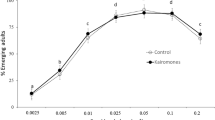Abstract
Recent research suggests that planktonic organisms in resting stages can perceive predators chemically and delay hatching to evade predation. Using a co-occurring predator–prey pair (Gambusia holbrooki Girard and Daphnia curvirostris Eylmann) from a Mediterranean floodplain wetland, this study tested for such predator-avoidance behaviour of Daphnia. Results show that hatching patterns of Daphnia were not reduced by the presence of different biomass levels of Gambusia. This could be due to the fact that the density of Gambusia in the wetland is high from late spring to late autumn, suggesting that delayed hatchlings would face increased mortality through consumptive predation.

Similar content being viewed by others
References
Blaustein L (1997) Non-consumptive effects of larval Salamandra on crustacean prey: can eggs detect predators? Oecologia 110:212–217
Cáceres CE, Schwalbach MS (2001) How well do laboratory experiments explain field patterns of zooplankton emergence? Freshwat Biol 46:1179–1189
Cousyn C, De Meester L (1998) The vertical profile of resting egg banks in natural populations of the pond-dwelling cladoceran Daphnia magna Straus. Arch Hydrobiol/Adv Limnol 52:127–139
De Meester L, De Jager H (1993) Hatching of Daphnia sexual eggs. II. The effects of age and a 2nd stimulus. Freshwat Biol 30:227–233
Hairston NG Jr (1987) Diapause as a predator-avoidance adaptation. In: Kerfoot WC, Sih A (eds) Predation: direct and indirect impacts on aquatic communities. University Press of New England, Hanover, NH, pp281–290
Hairston NG Jr (1998) Time travelers: what’s timely in diapause research? Arch Hydrobiol/Adv Limnol 52:1–15
Lampert W (1991) The dynamics of Daphnia magna in a shallow lake. Verh Int Verein Limnol 24:795–798
Lass S, Spaak P (2003) Chemically induced anti-predator defences in plankton: a review. Hydrobiologia 491:221–239
Lass S, Vos M, Wolinska J, Spaak P (2005) Hatching with the enemy: Daphnia diapausing eggs hatch in the presence of fish kairomones. Chemoecol 15:7–12
Li D (2002) Hatching responses of sub-social spitting spiders to predation. Proc R Soc Lond Ser B 269:2155–2161
Livdahl TP, Koenekoop RK, Futterweit SG (1984) The complex hatching response of Aedes eggs to larval density. Ecol Entomol 9:437–442
Marcus NH, Lutz RV, Burnett W, Cable P (1994) Age, viability, and vertical distribution of zooplankton resting eggs from an anoxic basin: Evidence of an egg bank. Limnol Oceanogr 39:206–210
Rengefors K, Karlsson I, Hansson LA (1998) Algal cyst dormancy: a temporal escape from herbivory. Proc R Soc Lond Ser B 265:1353–1358
Rojo C, Ortega-Mayagoitia E, Rodrigo MA, Alvarez-Cobelas M (2000) Phytoplankton structure and dynamics in a semiarid wetland, the National Park “Las Tablas de Daimiel” (Spain). Arch Hydrobiol 148:397–419
Sih A, Moore RD (1993) Delayed hatching of salamander eggs in response to enhanced larval predation risk. Am Nat 142:947–960
Sommer U, Gliwicz Z, Lampert W, Duncan A (1986) The PEG model of seasonal succession of planktonic events in freshwaters. Arch Hydrobiol 106:433–471
Spencer M, Blaustein L (2001) Risk of predation and hatching of resting eggs in the ostracod Heterocypris incongruens. J Crust Biol 21:575–581
Tollrian R, Harvell CD (1999) The ecology and evolution of inducible defences. Princeton University Press, Princeton, New Jersey
Acknowledgements
I thank M. García-Pulgar, M. Rodríguez, and S. Martín for assisting in isolating resting eggs and with laboratory work. Luc de Meester, Leon Blaustein and anonymous referees provided helpful comments on a previous manuscript draft. This study was financially supported by a UCLM research grant.
Author information
Authors and Affiliations
Corresponding author
About this article
Cite this article
Angeler, D.G. No diapause prolongation response of Daphnia in the presence of planktivorous mosquitofish (Gambusia holbrooki). Ecol Res 20, 619–622 (2005). https://doi.org/10.1007/s11284-005-0075-4
Received:
Accepted:
Published:
Issue Date:
DOI: https://doi.org/10.1007/s11284-005-0075-4




